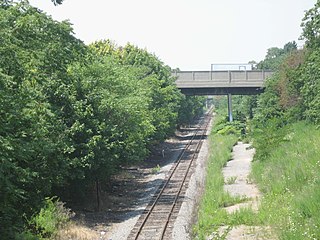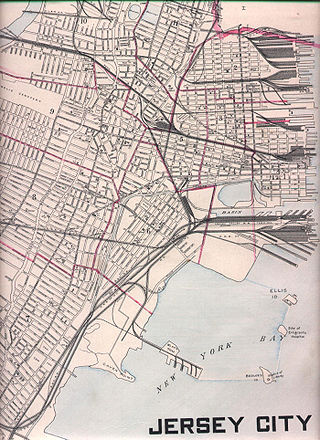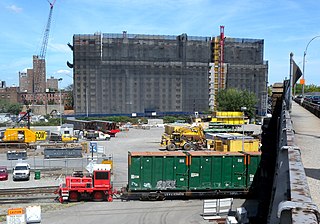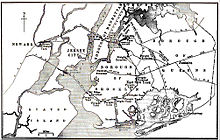
The New York and Atlantic Railway (NY&A) is a short line railroad on Long Island, within the southeastern portion of the U.S. state of New York. It was formed in 1997 to provide freight service over the tracks of the Long Island Rail Road, a public commuter rail agency which had decided to privatize its freight operations. A subsidiary of the Anacostia Rail Holdings Company, NY&A operates exclusively on Long Island and is connected to the U.S. mainland via CSX's Fremont Secondary over the Hell Gate Bridge. It also interchanges with New York New Jersey Rail's car float at the 65th Street Yard and US Rail of New York in Yaphank, New York. Its primary freight yard is Fresh Pond Junction in Queens. It has another yard, Pine Aire Yard, in northern Bay Shore, New York. The NY&A officially took over Long Island Rail Road's freight operations on May 11, 1997, with an initial franchise for 20 years.

The Howland Hook Marine Terminal, operating as GCT New York, is a container port facility in the Port of New York and New Jersey located at Howland Hook in northwestern Staten Island, New York City. It is situated on the east side of the Arthur Kill, at the entrance to Newark Bay, just north of the Goethals Bridge and Arthur Kill Vertical Lift Bridge.

A railroad car float or rail barge is a specialised form of lighter with railway tracks mounted on its deck used to move rolling stock across water obstacles, or to locations they could not otherwise go. An unpowered barge, it is towed by a tugboat or pushed by a towboat.

New York New Jersey Rail, LLC is a switching and terminal railroad that operates the only car float operation across Upper New York Bay between Jersey City, New Jersey and Brooklyn, New York. Since mid-November 2008, it has been owned by the Port Authority of New York and New Jersey, which acquired it for about $16 million as a step in a process that might see a Cross-Harbor Rail Tunnel completed.

The Oak Point Link, also known as the South Bronx–Oak Point Link, is a 1.9-mile (3.1 km) long railroad line in the Bronx, New York City, United States, along the east bank of the Harlem River. It connects the Metro-North Railroad's Hudson Line with the Harlem River Intermodal Yard and the CSX Transportation Oak Point Yard at the north end of the Hell Gate Bridge.

The South Brooklyn Railway is a railroad in the New York City borough of Brooklyn. It is owned by the government of New York City and operated by the New York City Transit Authority. Its original main line ran parallel to 38th Street from the Upper New York Bay to McDonald Avenue, and south on McDonald Avenue to the Coney Island Yards, mostly underneath the former Culver Shuttle and the IND Culver Line of the New York City Subway.

The Arthur Kill Vertical Lift Railroad Bridge is a rail vertical-lift bridge connecting Elizabethport, New Jersey and the Howland Hook Marine Terminal on Staten Island, New York, United States. The bridge was built by the Baltimore and Ohio Railroad in 1959 to replace the Arthur Kill Bridge, a swing bridge opened in 1890. It contains a single track that is used mainly to carry garbage out of New York City, as well as to transport freight to destinations in western Staten Island. The bridge parallels the Goethals Bridge, which carries Interstate 278. It has the longest lift span of any vertical-lift bridge in the world, with two 215-foot (66 m) towers and a 558-foot (170 m) truss span that allows a 500-foot (152 m) channel. It clears mean high water by 31 feet (9.45 m) when closed and 135 feet (41 m) when lifted.

The Port of New York and New Jersey is the port district of the New York-Newark metropolitan area, encompassing the region within approximately a 25-mile (40 km) radius of the Statue of Liberty National Monument.
The Cross-Harbor Rail Tunnel is a proposed freight rail transport tunnel under Upper New York Bay in the Port of New York and New Jersey between northeastern New Jersey and Long Island, including southern and eastern New York City.

The Bay Ridge Branch is a rail line owned by the Long Island Rail Road (LIRR) and operated by the New York and Atlantic Railway in New York City. It is the longest freight-only line of the LIRR, connecting the Montauk Branch and CSX Transportation's Fremont Secondary at Glendale, Queens with the Upper New York Bay at Bay Ridge, Brooklyn.

The Selkirk Hurdle is the term used by urban planners, railroad employees, politicians, and others to describe the route that must be taken by freight trains traveling between New York City and other points in downstate New York that are east of the Hudson River, and locations in the United States to the south and west. There are no rail freight bridges or tunnels that cross the Hudson River south of Selkirk, which is 10 miles (16 km) south of Albany and the home of Selkirk Yard, a major CSX classification yard. As a result, trains from Long Island and New York City must travel 140 miles (230 km) north to cross at Selkirk before continuing on their way. Advocates claim that this detour and the inefficiencies that result force New York City to rely more heavily on relatively-inefficient trucks than most parts of the United States, where freight trains are more common. However, at least for traffic to and from the west, this route was touted for its efficiency as the "Water Level Route" by the New York Central Railroad because trains using it did not have to climb over the Appalachian Mountains, and it is still used by the New York Central's successor, CSX, for traffic to both sides of the Hudson River.

Arlington Yard is a freight yard located on the North Shore Branch right of way of the Staten Island Railway in Staten Island, New York, United States. It lies west of the former Arlington station, east of Western Avenue, and north of the Staten Island Expressway in the Port Ivory neighborhood. The yard leads into the Travis Branch of the railway, the Howland Hook Container Terminal, and the Arthur Kill Lift Bridge to Elizabeth, New Jersey and the Chemical Coast and is part of the ExpressRail network.

Port Jersey, officially the Port Jersey Port Authority Marine Terminal and referred to as the Port Jersey Marine Terminal, is an intermodal freight transport facility that includes a container terminal located on the Upper New York Bay in the Port of New York and New Jersey. The municipal border of the Hudson County cities of Jersey City and Bayonne runs along the long pier extending into the bay.
Greenville Yard is a freight rail yard in the Port of New York and New Jersey. It is located on Upper New York Bay in Jersey City, New Jersey, adjacent and north of Port Jersey. Originally developed in 1904 by the Pennsylvania Railroad, it was later taken over by Conrail. It has been owned by the Port Authority of New York and New Jersey since 2010. It takes its name from the former municipality of Greenville, now part of the city.

National Docks Secondary is a freight rail line within Conrail's North Jersey Shared Assets Area in Hudson County, New Jersey, used by CSX Transportation. It provides access for the national rail network to maritime, industrial, and distribution facilities at Port Jersey, the Military Ocean Terminal at Bayonne (MOTBY), and Constable Hook as well as carfloat operations at Greenville Yard. The line is an important component in the planned expansion of facilities in the Port of New York and New Jersey. The single track right of way comprises rail beds, viaducts, bridges, and tunnels originally developed at the end of the 19th century by competing railroads.

The 65th Street Yard, also Bay Ridge Rail Yard, is a rail yard on the Upper New York Bay in Sunset Park and Bay Ridge, Brooklyn. Equipped with two transfer bridges which allow rail cars to be loaded and unloaded onto car floats, it is the last of once extensive car float operations in the Port of New York and New Jersey. Located adjacent to the Brooklyn Army Terminal, it provided a major link in the city's rail freight network in the first half of the twentieth century. It was later used as a conventional railroad yard at the end of the LIRR/NY&A Bay Ridge Branch. The new transfer bridges were constructed in 1999, but remained unused until the transfer bridges were activated in July 2012.

Harlem River Yards is a waterfront industrial property located in the Port Morris neighborhood of The Bronx in New York City. It is operated by Harlem River Yard Ventures, part of the Galesi Group, under a 99-year lease with the State of New York signed in 1991.

Fresh Pond Junction is a freight yard in the Ridgewood and Glendale neighborhoods of Queens in New York City. It is operated by the New York & Atlantic Railway, which serves Long Island using tracks owned by the Long Island Rail Road (LIRR). The yard has operated since the early 20th century and is the primary rail freight yard on the island.

ExpressRail is a network of on- or near-dock rail yards supporting intermodal freight transport at the major container terminals of the Port of New York and New Jersey. The development of dockside trackage and rail yards for transloading has been overseen by the Port Authority of New York and New Jersey, which works in partnership with other public and private stakeholders. As of 2019, four ExpressRail facilities were in operation, with a total built capacity of 1.5 million lifts.























